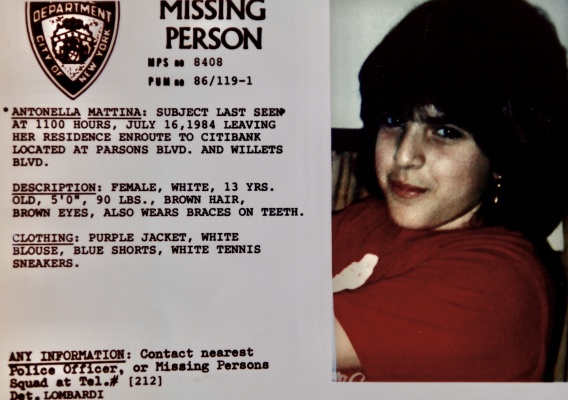Antonella Mattina Found Dead With Stab Wounds in Yorktown New York
Antonella Mattina was a 12-year-old girl living with her family in Flushing, Queens, New York. Born into a hardworking immigrant household, she was described by neighbors and relatives as bright, outgoing, and deeply connected to her close-knit community. Like many children of her age, she carried a balance of responsibility and innocence—trusted by her parents to run small errands, yet still in the tender stages of childhood. Antonella had a promising future ahead, with classmates and teachers later recalling her as dependable and kind.
The Day of Disappearance
On the afternoon of July 16, 1984, Antonella was asked by her parents to perform a simple errand: deposit money at a local Citibank branch located in the Linden Vue Shopping Center in Flushing. It was a warm summer day, the streets alive with families, shoppers, and children on school break. For Antonella, this errand was not unusual. She had been entrusted with similar responsibilities before, as many families in tight neighborhoods leaned on their children for small but important tasks.
What should have been a short and uneventful trip instead became the last time her family would see her alive. Witnesses saw her near the bank, but after that, Antonella vanished. Her disappearance sparked panic in the Mattina household and quickly spread through the neighborhood. Flyers were posted, police were contacted, and the Flushing community mobilized in an attempt to find the missing girl.
The Immediate Search Efforts
The New York Police Department initiated a missing persons investigation. Hundreds of tips poured in, but none produced the breakthrough detectives needed. Volunteers scoured streets, backyards, parks, and abandoned lots. Neighborhood vigils were held, prayers were spoken in both English and Italian, and the local press carried her photograph on front pages.
Despite these efforts, weeks turned into months. Leads dried up, and the once-frantic search slowed into the agonizing uncertainty that haunts families of the missing. For the Mattina family, each passing year without answers added to the unbearable weight of grief and confusion.
The Discovery in Yorktown
Three years later, on Thanksgiving Day in November 1987, a grim discovery was made in Yorktown, Westchester County, New York—an area north of the city, near the Taconic State Parkway. Hikers came across human remains in a wooded area. The condition of the remains suggested they had been there for years. Detectives collected the evidence and began the painstaking process of identification.
Dental records were used to confirm the identity. Within days, officials announced that the remains belonged to Antonella Mattina. The revelation devastated her family and reopened old wounds in the Queens community. The joyful child who had vanished into mystery was now confirmed dead, her body discarded miles away from where she was last seen.
The Cause of Death
Further examination revealed that Antonella had suffered multiple stab wounds to the chest. This discovery transformed the investigation from a missing persons case into a homicide inquiry. The brutality of the attack underscored the malicious intent of the killer. Law enforcement officials redoubled their efforts to identify the person responsible, but the trail was already cold after three long years.
Law Enforcement Challenges
From the outset, detectives faced difficulties. Evidence at the crime scene had been compromised by time, weather, and animal activity. No immediate physical clues such as clothing, personal belongings, or weapons could directly point to a suspect. Witnesses who might have remembered something unusual in 1984 were harder to track down years later, and memories had faded. The case highlighted the challenges of solving crimes involving missing children whose remains are discovered long after the disappearance.
Suspicions and Theories
Over the years, investigators and true crime researchers speculated about possible suspects. One name that often arose was Alex Mengel, a man later suspected of multiple violent crimes in the New York region during the same era. Mengel was linked to other abductions and murders, leading some to theorize that he may have been involved in Antonella’s death. However, no conclusive evidence tied him directly to her case, and he died before he could be held accountable for other alleged crimes.
The lack of definitive answers left Antonella’s case officially unsolved. Detectives continued to keep it open, and occasional reviews brought renewed attention, but the killer has never been formally identified.
The Community’s Grief
The impact of Antonella’s murder lingered in Queens and beyond. Parents who once felt comfortable allowing their children to run small errands began to second-guess even the simplest tasks. Her story served as a cautionary tale of vulnerability in urban life, where safety could be shattered in a single moment. For her classmates, the memory of her smile remained locked in childhood photographs, forever frozen at the age of twelve.
For her family, the discovery of her remains did not provide closure—it confirmed the horror they had feared, but it left them without justice or explanation. Birthdays, anniversaries, and holidays became painful reminders of a life cut short.
The Long Shadow of the Case
Antonella’s murder has been cited in discussions about missing children in New York during the 1980s, an era marked by several high-profile disappearances. Her case reflected the limitations of forensic science at the time, when DNA technology was still in its infancy. Today, there is hope that advancements in cold case investigations, including modern DNA analysis and digital record-keeping, could one day provide answers.
Memorial and Remembrance
Decades after her death, Antonella’s memory remains alive in her community. In 2025, New York City co-named the intersection of 25th Drive and Parsons Boulevard—near where she was last seen—as “Antonella Mattina Way.” The street dedication ceremony was attended by family members, classmates, and community leaders. The co-naming not only honored her memory but also ensured that future generations would know her story.
This symbolic act turned the location of her last known steps into a site of remembrance and resilience. For her family, it was a bittersweet recognition: a public acknowledgment of their loss and their daughter’s life, even as the case itself remains unresolved.
Legacy and Ongoing Questions
The legacy of Antonella Mattina’s murder is one of grief, unanswered questions, and determination. Her case continues to be referenced by cold case investigators, journalists, and advocates who work to keep the memory of victims alive. The dedication of a street in her name stands as a reminder that while justice has yet to be delivered, her life has not been forgotten.
The ongoing mystery of who killed Antonella remains an open wound for her family and her community. Each year, renewed interest in cold cases brings her story back into the public consciousness, with hopes that one day new evidence may surface, or someone may step forward with the information needed to close the case.
Discover more from City Towner
Subscribe to get the latest posts sent to your email.




